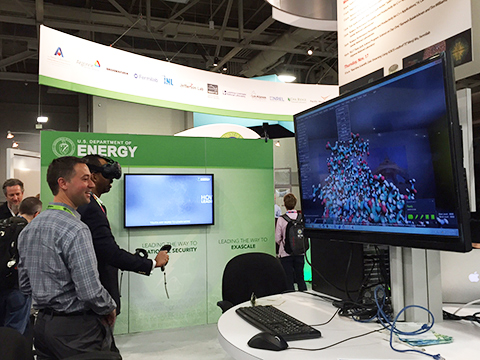Advanced Computing, Mathematics and Data
Research Highlights
December 2016
Making Virtual a Reality
PNNL showcases new virtual reality research at SC16
During the recent International Conference for High Performance Computing, Networking, Storage and Analysis (colloquially known as SC16), Nick Cramer, a Visual Analytics researcher, debuted “Molecular Motion in Virtual Reality,” an immersive showcase that allowed visitors to the Department of Energy’s booth to use virtual reality, or VR, hardware to explore a molecule modeled on the Cascade supercomputer housed within the Environmental Molecular Sciences Laboratory user facility at Pacific Northwest National Laboratory.
While the SC16 demonstration provided a unique attraction to the DOE booth, Cramer noted Molecular Motion in Virtual Reality resulted from both opportune connections and well-thought, diverse collaborations.
According to Cramer, VR, which uses interactive computers and software with specialized displays to generate realistic, immersive environments, is a growing research capability he is stewarding at the laboratory. Initially, his work started by visiting a VR startup in Seattle. From there, the Computational and Statistical Analytics Division’s Kickstarter program (modeled after crowdsourcing), helped Cramer and Nathan Hilliard, from CSA’s Data Sciences group, fund further VR development.
Exploring a VR component for molecular visualization came into the picture when Nathan Baker, Advanced Computing, Mathematics, and Data Division Director, sought to build on the Adaptive Poisson-Boltzmann Solver (APBS) that solves the equations of continuum electrostatics for large biomolecular assemblages. The National Institutes of Health supports the APBS project. From there, the PNNL-VR connection reached Marc Baaden at France’s Institut de Biologie Physico-Chimique, who collaborated with Cramer on extending UnityMol, a molecular editor, viewer, and prototyping platform, to support VR using the HTC Vive (headset, controllers, etc.) for molecule visualization.
“This connection gave us a general molecule visualization VR capability,” Cramer explained. “We could also visualize output from the electrostatics software created under Nathan [Baker]’s NIH APBS project.”
The SC16 demonstration provided an opportunity to connect these new VR functionalities via yet another collaboration: between Cramer; Wendy Shaw, Physical Science Division Director; and the PSD catalysis research team, including scientists Simone Raugei and Bojana Ginovska, using Cascade and PNNL Institutional Computing resources. Together, they worked toward visualizing the molecule dynamics for hydrogenase and nitrogenase enzymes in VR. Hydrogenase catalyzes the reversible oxidation of molecular hydrogen (H2), while nitrogenase reduces nitrogen (N2) to ammonia (NH3). Both enzymes are important to the ongoing studies for designing clean biological energy sources.
“The journey of this demo, from the original VR exploration in NSD to the NIH project and the international collaboration for UnityMol and, finally, to the PSD catalysis project, was made possible by key cross-organizational connections within PNNL and the diverse projects we share among our many collaborators and sponsors. It has been great to see how VR research can and will continue to evolve at the lab,” Cramer added.

